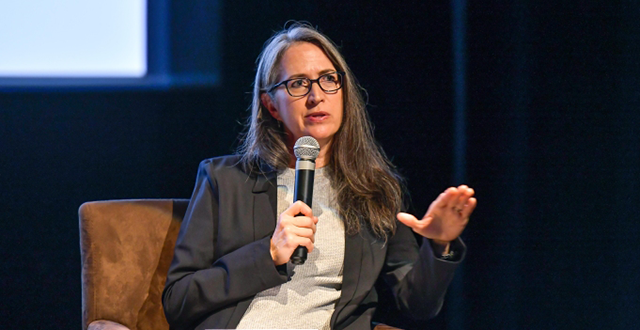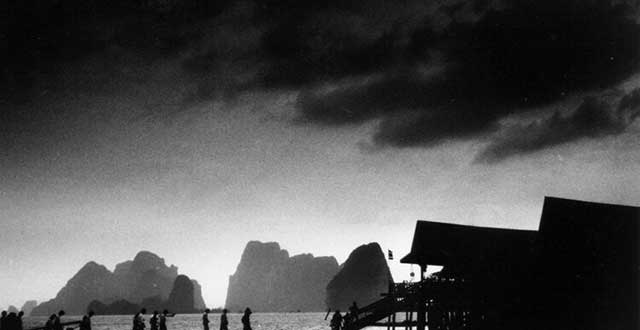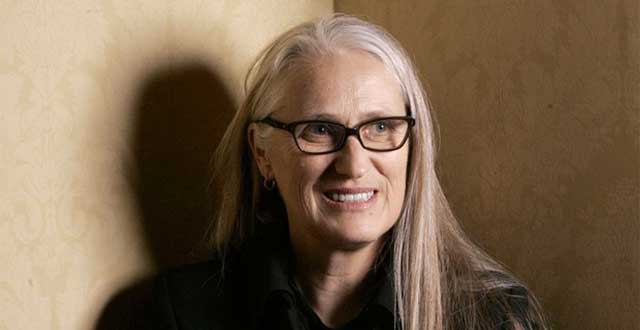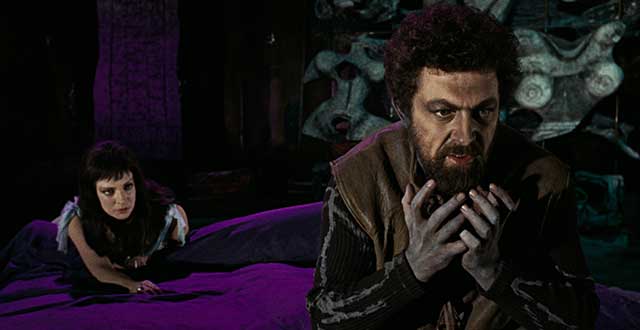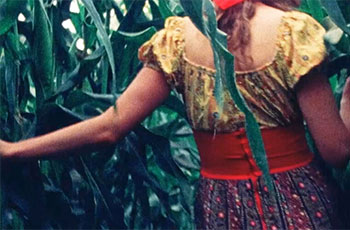News
Margaret Bodde, From Martin Scorsese’s Film Foundation, Kicks Off the Lumière Festival’s Classic Film Market
Lise Pedersen
A non-profit organization dedicated to film preservation and the exhibition of restored and classic cinema, the Foundation has overseen the restoration of over 900 films to date. In her keynote address at the Lumière Festival’s Classic Film Market, Bodde explained how it came about.
“It was 1990 and Martin Scorsese and a group of his fellow filmmakers like Spielberg, Lucas, Coppola, Kubrick and Pollack were really agitated at the idea that the cinema they grew up loving was literally fading away.
“At the time, there was no home video market and the studios had not instituted a systematic approach to their collections. So they created the Film Foundation to build a bridge between studios and the non-profit archives to raise awareness and funds for film preservation projects.”
As time went on, the Film Foundation turned its attention to independent films too. “Films that are independently produced are quite vulnerable, they are not housed necessarily in an archive or a studio vault,” Bodde explained. “What’s amazing is that, as these films are brought back out, it revitalizes filmmakers – women, people of color – that weren’t given proper attention when they were made, like Nina Menkes’ ‘The Bloody Child’ (1996) or ‘The Juniper Tree’ (1990) by Nietzchka Keene,” she went on.
In addition, the Foundation also works on experimental and avant-garde films through an annual grant, which has helped restore works by the likes of Andy Warhol, Jonas Mekas or Barbara Hammer. “If indie films are at risk of being lost, avant-garde, experimental films are orders of magnitude beyond that,” said Bodde.
The dialogue is ongoing between the Foundation and the film archives, which are invited to submit projects to the Foundation’s board once a year – a selection is made by the board based on criteria such as historical and cultural relevance, the film’s condition and its estimated restoration budget.
“The archives are our allies,” she said. “The studios are more challenging. They are not moved by morality, they are moved by economy, so you have to see what’s in their best interest.
“There has to be a recognition on the part of the studios that there is value to the library. At the moment, everyone is looking for that horrible word: ‘content’ – things they can monetize – and the library would be one of those. So you appeal to the fact that there is an audience for everything.”
In 2007, the Film Foundation decided to extend its reach beyond the U.S. with its World Cinema Project (WCP), launched in collaboration with its long-time partner Cineteca di Bologna, and a decade later the African Film Heritage Project was born. To date, 46 films have been restored under the WCP.
“The WCP is unique because once at-risk films are identified and restored, and the program takes on available distribution rights. Often, the films have only been seen in their country of origin, and we help bring them out and they become these discoveries,” said Bodde, who brought clips of one such film, the recently restored Iranian cult movie “Chess of the Wind” (1976) by Mohammad Reza Aslani.
Confiscated during the Islamic Revolution it was believed to be lost. Rediscovered in 2014, it was smuggled to Paris for restoration. The film has toured the festival circuit and is distributed globally by Foundation partners like France’s leading heritage film distributor Carlotta and Criterion in the U.S., which has released several DVD boxsets of WCP movies. It is partnerships like these that give restored films a second lease of life, said Bodde.
“As one newspaper said: It’s like walking around with a film festival in your bag,” she joked. “To put these films into context the way Criterion does so well, with essays and background and notes about the restoration, is fantastic,” she enthused. “These partnerships help the films reach a wider audience: they fill in a lot of gaps and shift our understanding of film culture.”
Asked about the future and the ever-growing changes in film consumption, accelerated by the pandemic, Bodde said: “We’ll keep doing what we do. The technology changes – it changed in 1927 with sound and then color! How we look at film’s changes: we stream things. I can watch a film on my phone if I so choose. But the films still have the same power – I mean not on my phone, I don’t think,” she joked. “But they are still communicating and inspiring, so we’ll keep that as our guiding light.”
The MIFC runs alongside the Lumière Film Festival in Lyon until Oct. 15.
NOTES ON FILM & RESTORATION
Tom Quinn, the founder and head of Neon, is taking a bold and necessary step forward in the name of cinema. Neon will be releasing Apichatpong Weerasethakul’s Memoria as a “road show”—going one theatre in one city at a time across the country…and that’s it. No Blu-ray, no DVD, and most importantly of all: no streaming. No, Memoria will not be sharing a “swimlane” with (imagine algorhythmically generated “similar” films here). You will have to see it in a theatre, or miss it.
Will the film eventually turn up on some other platform? Possibly. But the gesture is very important.
In his resplendent Charles Eliot Norton lectures on the “crisis” of music in the 20th century, Leonard Bernstein posed the rhetorical question: does this focus on music and its development actually matter? Is it relevant? “The world totters,” said Bernstein, “governments crumble, and we are poring over musical phonology and syntax. Isn’t it a flagrant case of elitism? Well, in a way it is. Certainly not elitism of class—economic, social or ethnic—but of curiosity, that special inquiring quality of the intelligence. And it was ever thus. But these days, the search for meaning through beauty and visa-versa becomes even more important, as each day mediocrity and art-mongering increasingly uglify our lives. And the day when this search for John Keats’ truth/beauty ideal become irrelevant, then we can all shut up and go back to our caves. Meanwhile, to use that unfortunate word again, it is thoroughly relevant.”
These lectures were delivered almost 50 years ago. They could have been written yesterday.
We have arrived at a strange moment. The terms “elitism” and “elites” have been rendered so elastic as to become all but meaningless, and the same could be said of “friend,” “community,” “freedom” and “democratic.” And, of course, “social.” Market-driven logic is sold, relentlessly, as “reality.” And in the process, art is treated as a doormat, a tabula rasa on which one can project any half-baked “idea” or program. And the artists? Or the people who give themselves to art? Who pronounce the word cinema without shame, but with real pride? I can say from personal experience that the labels come fast and furious at the mere mention of the word. My own favorite was “effete,” a word that good old Spiro Agnew used to flog from the podium.
The reality of the market is not reality, period: there is an infinity of dimensions to being alive, and art is a precious reminder of just that. It is the polar antithesis of commerce, and it addresses us not as a consumer but as a fellow human being. That goes for every single title that’s been restored and preserved by The Film Foundation since its inception, including the 2000 title Mysterious Object at Noon, the first feature from Apichatpong Weerasethakul, known to many as Joe.
It’s wonderful that so much is available now, to see at home. The trade-off is that it is offered to us in the basest possible manner, determined by a bottom-line, lowest-common-denominator approach to programming, equalizing absolutely every moving image under the sun, and all but encouraging the consumer to bail the minute they get bored or distracted or confused or challenged or anything but lulled by more of the same. Again.
Films should be widely available. They should also be valued. That was why John Cassavetes made it so difficult to see his films when he was alive, and that is the point of Joe and Tom’s grand gesture.
- Kent Jones
Follow us on Instagram, and Twitter!
MYSTERIOUS OBJECT AT NOON (Thailand, 2000. d. Apichatpong Weerasethaku)
Restored in 2013 by the Austrian Film Museum and Cineteca di Bologna/L’Immagine Ritrovata laboratory, in association with The Film Foundation’s World Cinema Project, LISTO laboratory in Vienna, Technicolor Ltd in Bangkok, and Apichatpong Weerasethakul. Restoration funded by Doha Film Institute.
L'amore per il cinema al centro del Festival Lumière
Fabien Lemercier
"As for me, addressing you here, I admire everything, like a savage." This quote from Victor Hugo, favoured by the much missed Bertrand Tavernier (who was President of the Institut Lumière from its creation in 1982) to whom the 13th edition of the Lumière Festival (steered by Thierry Frémaux) is clearly set to pay tribute, perfectly illustrates the passion that is invested into the biggest global event dedicated to heritage cinema. It’s an immoderate love for the 7th art which has transformed the festival into an incredibly popular gathering, which will once again raise its curtain from 9 to 17 October with a colossal line-up of over 420 films.
The 2021 Lumière Award is set to be handed to Jane Campion, who will form the focus of a retrospective, as well as delivering a masterclass on 15 October. Also worth a mention, within the context of the "Permanent History of Women Filmmakers” section, is a retrospective dedicated to Kinuyo Tanaka, who was a woman director in the golden age of Japanese film.
Stealing focus among the various guests the festival plans to honour (with several premières gracing the agenda) are Paolo Sorrentino (who will deliver a masterclass on 10 October and whose film The Hand of God [+] is set for a screening), Marco Bellocchio (notably with his documentary Marx Can Wait [+]), Maggie Gyllenhaal (The Lost Daughter [+]), Bulle Ogier (also delivering a masterclass), Catherine Corsini (The Divide [+]), Joachim Trier, presenting The Worst Person in the World [+], Juan Antonio Bayona, Édouard Baer (with Adieu Paris, among other works), composer Philippe Sarde (who’s also planning a masterclass), Gessica Généus (Freda [+]), Yvan Attal (The Accusation [+]), Christian Carion (My Son [+]) and the trio Gaspar Noé - Dario Argento - Françoise Lebrun with Vortex [+]. Tributes to the sorely missed Sydney Pollack and Gilles Grangier also deserve a mention.
Standing out in the Celebrations category are "1971, The Birth of Blaxploitation", "Clint Eastwood: 50 Years of A Filmmaking Career", the 30-year anniversary of Maurice Pialat’s Van Gogh and a tribute to Fernando Solanas. The Re-Release Events line-up, meanwhile, will shine a light on the adventures of Antoine Doinel by way of François Truffaut’s films, as well as showcasing the Infernal Affairs trilogy and three Japanese cult horror films.
The "Big Classics in Black and White" line-up will include works coming courtesy of Buñuel, Duvivier, Carné, Kurosawa, Welles, Wilder, Lubitsch, Franju and Fellini, to name a few, while the "Sublime Moments of Silent Film" selection will notably present works by Eisenstein, along with Louis Feuillade’s Judex series. Likewise on the agenda, we find "Epic Screenings" (Pollack, De Palma, Swain, Barboni, Chahine, etc.), documentaries about film, a Jurassic All-Nighter, a string of titles supported by the Lumière Classics label (directed by McCarey, Powell and Pressburger, Renoir, Scola, Dmytryk, Corbucci, Tanner, Decoin, Clément, Castellani, Berlanga and Bardem, Fernández, etc.) and "Treasures and Curiosities" (Nemec, Jancsó, Makavejev).
And one to mention in closing, running from 12 to 15 October, is the 9th edition of the International Classic Film Market which will honour Switzerland, will feature America’s Margaret Bodde (who oversees The Film Foundation founded by Martin Scorsese) as its Expert Guest, and will decipher the current state of the sector during thematic round table talks, in addition to the usual film screenings and presentations of various line-ups.
NOTES ON FILM & RESTORATION
Michael Powell’s glorious version of Béla Bartók’s 1911 one-act opera began life with its star, the American operatic bass singer Norman Foster (not to be confused with the actor and director). Foster wanted to pair the opera with Bartók’s equally compact ballet of 1916, The Miraculous Mandarin, and film them at a new studio in Salzburg, for German television. Foster came to Powell via production designer Hein Heckroth, one of the director’s most cherished collaborators. Foster would sing and play the role of Bluebeard and the Uruguayan mezzosoprano Ana Racquel Satre would be Bluebeard’s fourth wife Judith. Powell bought a recording with Dietrich Fischer-Dieskau as Bluebeard and he was sold (the ballet, on the other hand, left him non-plussed and that idea was dropped). He ordered a copy of the score and got to work on a script, and commenced to criss-crossing Europe in his red land rover for finance and production meetings, alighting in Vienna, then Heckroth’s home base of Frankfurt, then Munich, then Salzburg, then Zagreb to meet with the conductor Milan Horvath. Shooting started while the studio was still being built, Powell and Heckroth conjured wonders out of color and lights and polystyrene forms and camera placement and movement, and the production wrapped in eight and a half days. “What did it matter that there was not enough money to pay everybody the fees that had been agreed?” wrote Powell in the second volume of his autobiography. “There is always something a little unreal about being paid for doing something that you love to do. All of us were artists, and all of us had a little of this feeling—fortunately for Norman. We ate well, we drank well, and we slept well, and we loved one another. We knew what we were doing, and we saw that it was good. We had made new friends, and no enemies. It was one of the most delightful experiences of my life in movies.” After it was broadcast on German television (in black and white!), Bluebeard’s Castle languished in obscurity for many years. It has just been restored by the BFI and The Film Foundation, and will be screened at this year’s New York Film Festival.
I realize that since I started writing these posts, I’ve given a lot of attention to titles by Michael Powell, the majority of them made with Emeric Pressburger. For many reasons. On a personal note, I came to Powell’s films through Martin Scorsese, the founder of The Film Foundation, and Thelma Schoonmaker, who was married to Powell in the last years of his life and who has devoted so much time and loving care to the meticulous restoration and preservation of his films and his writings. Margaret Bodde and I discovered a lot of these movies in a screening room with Marty and Thelma, and over the years I’ve come back to them again and again. And with every new viewing, they seem to become more wondrous—that’s the way it is with all great films. There have been many great filmmakers, but only a very few like Michael Powell, the spirit of whose work is all but inseparable from the spirit of the art form itself.
- Kent Jones
Follow us on Instagram, and Twitter!
HERZOG BLAUBARTS BURG (BLUEBEARD'S CASTLE) (1963, d. Michael Powell)
Restored by the BFI National Archive and The Film Foundation in association with The Ashbrittle Film Foundation. Restoration funding provided by the BFI National Archive, The Louis B. Mayer Foundation and The Film Foundation.
